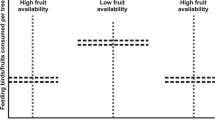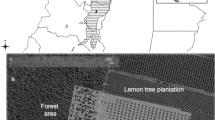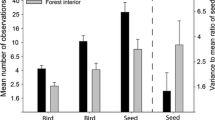Abstract
Seed dispersal by avian frugivores has driven the invasive success of numerous exotic fleshy-fruited plant species around the world. Birds’ movements are often directed toward food sources, producing seed shadows that are highly structured in space. The distribution of native fleshy-fruited plants in a landscape could thus form a spatial template for the contagious spread of exotic fleshy-fruited species in the early stages of invasion. We compared seed rain beneath fleshy-fruited and dry-fruited native-tree canopies in forested habitats and open fields in southeastern Michigan. We predicted that exotic seed rain would be highest beneath the canopies of fleshy-fruited plants, and that localities with higher densities of fruit-bearing fleshy-fruited plants would receive more exotic seed rain. Our results suggest that the seed shadows of exotic fleshy-fruited species are strongly influenced by the spatial distributions of native fleshy-fruited trees, and by the local density of fleshy-fruited plants. Over 92 % of exotic seeds were dispersed beneath fleshy-fruited trees, whereas less than 8 % of exotic seeds were dispersed beneath dry-fruited trees. Exotic seed rain was positively related to the local density of fleshy-fruited plants in forest, but not in open fields. Our study shows how shared dispersal syndromes and frugivore behavior influence the seed shadows of avian-dispersed exotic plants, enabling spatially explicit predictions of invasive spread in their novel ranges.




Similar content being viewed by others
References
Anderson S, Heiss-Dunlop S, Flohr J (2006) A moving feast: the influence of landscape context on bird-mediated seed rain into conservation areas. Fifteenth Australian weeds conference, pp 67–71
Aronson MFJ, Handel SN, Clemants SE (2007) Fruit type, life form and origin determine the success of woody plant invaders in an urban landscape. Biol Invasions 9:465–475
Aslan C, Rejmánek M (2012) Native fruit traits may mediate dispersal competition between native and non-native plants. NeoBiota 12:1–24
Augspurger CK, Kitajima K (1992) Experimental studies of seedling recruitment from contrasting seed distributions. Ecology 73:1270–1284
Bartuszevige AM, Gorchov DL (2006) Avian seed dispersal of an invasive shrub. Biol Invasions 8:1013–1022
Beckman NG, Rogers HS (2013) Consequences of seed dispersal for plant recruitment in tropical forests: interactions within the seedscape. Biotropica 45:666–681
Bliss CI, Fisher RA (1953) Fitting the negative binomial distribution to biological data. Biometrics 9:176–200
Brym ZT, Allen D, Ibáñez I (2014) Community control on growth and survival of an exotic shrub. Biol Invasions 16:2529–2541
Buckley YM, Anderson S, Catterall CP et al (2006) Management of plant invasions mediated by frugivore interactions. J Appl Ecol 43:848–857
Carlo TA, Morales JM (2008) Inequalities in fruit-removal and seed dispersal: consequences of bird behaviour, neighbourhood density and landscape aggregation. J Ecol 96:609–618
Carlo TA, Tewksbury JJ (2014) Directness and tempo of avian seed dispersal increases emergence of wild chiltepins in desert grasslands. J Ecol 102:248–255
Carlo TA, Garcia D, Martinez D et al (2013) Where do seeds go when they go far? Distance and directionality of avian seed dispersal in heterogeneous landscapes. Ecology 94:301–307
Clark CJ, Poulsen JR, Connor EF et al (2004) Fruiting trees as dispersal foci in a semi-deciduous tropical forest. Oecologia 139:66–75
Craves JA, Wloch D (2012) Fruit seeds of southern Michigan, an online guide. 2012 edn. Rouge river bird observatory, University of Michigan-Dearborn. http://seedguide.blogspot.com
Dean WRJ, Milton SJ (2000) Directed dispersal of Opuntia species in the Karoo, South Africa: are crows the responsible agents? J Arid Environ 45:305–314
Deckers B, Verheyen K, Vanhellemont M et al (2008) Impact of avian frugivores on dispersal and recruitment of the invasive Prunus serotina in an agricultural landscape. Biol Invasions 10:717–727
Dostál P (2010) Post-dispersal seed mortality of exotic and native species: effects of fungal pathogens and seed predators. Basic Appl Ecol 11:676–684
Eriksson O, Jakobsson A (1998) Abundance, distribution and life histories of grassland plants: a comparative study of 81 species. J Ecol 86:922–933
Fedriani JM, Wiegand T (2014) Hierarchical mechanisms of spatially contagious seed dispersal in complex seed-disperser networks. Ecology 95:514–526
Ferguson RN, Drake DR (1999) Influence of vegetation structure on spatial patterns of seed deposition by birds. NZ J Bot 37:671–677
Garcia D, Obeso JR, Martinez I (2005) Spatial concordance between seed rain and seedling establishment in bird-dispersed trees: does scale matter? J Ecol 93:693–704
Gosper CR, Stansbury CD, Vivian-Smith G (2005) Seed dispersal of fleshy-fruited invasive plants by birds: contributing factors and management options. Divers Distrib 11:549–558
Herrera CM, Jordano P, Lopez-Soria L et al (1994) Recruitment of a mast-fruiting, bird-dispersed tree: bridging frugivore activity and seedling establishment. Ecol Monogr 64:315–344
Janzen DH (1970) Herbivores and the number of tree species in tropical forests. Am Nat 104:501–528
Jordano P, Schupp EW (2000) Seed disperser effectiveness: the quantity component and patterns of seed rain for Prunus mahaleb. Ecol Monogr 70:591–615
Karubian J, Sork VL, Roorda T et al (2010) Destination-based seed dispersal homogenizes genetic structure of a tropical palm. Mol Ecol 19:1745–1753
Kwit C, Levey DJ, Turner SA et al (2007) Out of one shadow and into another: causes and consequences of spatially contagious seed dispersal by frugivores. In: Dennis AJ, Schupp EW, Green RJ, Westcott DA (eds) Seed dispersal: theory and its application in a changing world. CABI, Wallingford
Levine JM, Murrell DJ (2003) The community-level consequences of seed dispersal patterns. Annu Rev Ecol Evol Syst 34:549–574
Loiselle BA (1990) Seeds in droppings of tropical fruit-eating birds: importance of considering seed composition. Oecologia 82:494–500
Maron JL, Vila M (2001) When do herbivores affect plant invasion? Evidence for the natural enemies and biotic resistance hypotheses. Oikos 95:361–373
Martin AC, Barkley WD (1961) Seed identification manual. University of California Press, Berkeley
McCay TS, McCay DH, Czajka JL (2009) Deposition of exotic bird-dispersed seeds into three habitats of a fragmented landscape in the northeastern United States. Plant Ecol 203:59–67
McDonnell MJ (1986) Old field vegetation height and the dispersal pattern of bird-disseminated woody plants. Bull Torrey Bot Club 113:6–11
Mitchell CE, Power AG (2003) Release of invasive plants from fungal and viral pathogens. Nature 421:625–627
Morales JM, Rivarola MD, Amico G et al (2012) Neighborhood effects on seed dispersal by frugivores: testing theory with a mistletoe-marsupial system in Patagonia. Ecology 93:741–748
Murray KG (1988) Avian seed dispersal of three neotropical gap-dependent plants. Ecol Monogr 58:271–298
Rejmánek M (2014) Invasive trees and shrubs: where do they come from and what we should expect in the future? Biol Invasions 16:483–498
Richardson DM, Allsopp N, D’Antonio CM et al (2000) Plant invasions: the role of mutualisms. Biol Rev 75:65–93
SAS Institute Inc. (1989–2007) JMP, Version Pro 11. Cary, NC
Schupp EW, Milleron T, Russo SE (2002) Dissemination limitation and the origin of species-rich tropical forest. In: Levey DJ, Silva WR, Galetti M (eds) Seed dispersal and frugivory: ecology, evolution, and conservation. Oxford University Press, Oxford, pp 19–43
Silander JA, Klepeis DM (1999) The invasion ecology of Japanese barberry (Berberis thunbergii) in the New England landscape. Biol Invasions 1:189–201
Takahashi K, Kamitani T (2004) Factors affecting seed rain beneath fleshy-fruited plants. Plant Ecol 174:247–256
Vila M, Maron JL, Marco L (2005) Evidence for the enemy release hypothesis in Hypericum perforatum. Oecologia 142:474–479
Wenny DG (2001) Advantages of seed dispersal: a re-evaluation of directed dispersal. Evol Ecol Res 3:51–74
Westcott DA, Fletcher CS (2011) Biological invasions and the study of vertebrate dispersal of plants: opportunities and integration. Acta Oecol 37:650–656
White E, Vivian-Smith G (2011) Contagious dispersal of seeds of synchronously fruiting species beneath invasive and native fleshy-fruited trees. Austral Ecol 36:195–202
Yamamura K (1999) Transformation using (x + 0.5) to stabilize the variance of populations. Res Popul Ecol 41:229–234
Young JA, Young CG (1992) Seeds of woody plants in North America. Dioscorides Press, Oregon
Zamora R, Matías L (2014) Seed dispersers, seed predators, and browsers act synergistically as biotic filters in a mosaic landscape. PLoS One 9:e107385
Acknowledgments
This work was supported by a Mary R. Swales grant to NOB, awarded by the University of Michigan Museum of Zoology, and a Graduate Student Research Grant to NOB, awarded by the Rackham School of Graduate Studies at the University of Michigan. We thank J. Vandermeer, M. Hunter, and R. Burnham for helpful discussions. We also thank M. Cruz, B. Miller, D. Gross, Z. Stamplis, and A. Iverson for helping with fieldwork. Three anonymous reviewers provided helpful comments on the manuscript.
Author information
Authors and Affiliations
Corresponding author
Electronic supplementary material
Below is the link to the electronic supplementary material.
Rights and permissions
About this article
Cite this article
Bonilla, N.O., Pringle, E.G. Contagious seed dispersal and the spread of avian-dispersed exotic plants. Biol Invasions 17, 3409–3418 (2015). https://doi.org/10.1007/s10530-015-0966-4
Received:
Accepted:
Published:
Issue Date:
DOI: https://doi.org/10.1007/s10530-015-0966-4




